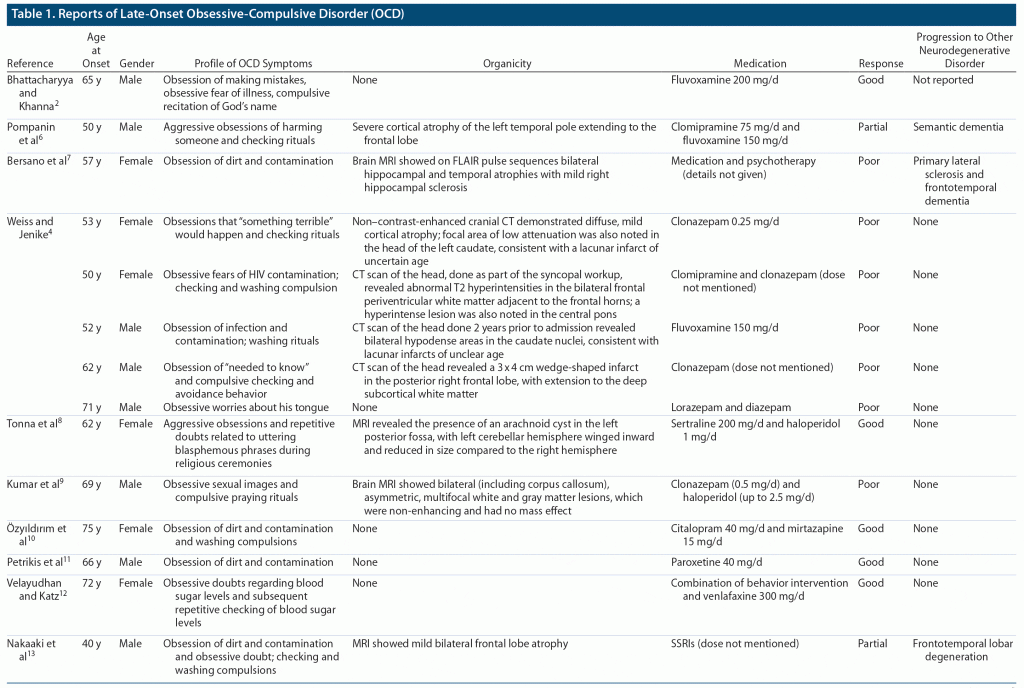Prim Care Companion CNS Disord 2023;25(2):22cr03263
To cite: Uvais NA. Late-onset obsessive-compulsive disorder with religious obsessions. Prim Care Companion CNS Disord. 2023;25(2):22cr03263.
To share: https://doi.org/10.4088/PCC.22cr03263
© 2023 Physicians Postgraduate Press, Inc
aDepartment of Psychiatry, Iqraa International Hospital and Research Centre, Calicut, Kerala, India
*Corresponding author: N. A. Uvais, MBBS, DPM, Iqraa International Hospital and Research Centre, Calicut, Kerala, India ([email protected]).
Obsessive-compulsive disorder (OCD) is a common psychiatric disorder that usually begins in the mid to late 20s to early 30s.1 Studies exploring the prevalence of OCD in older adults are few. The Epidemiologic Catchment Area study2 reported that the prevalence rate of OCD in the ≥ 65 years age group was 1.2%. Clinical and phenomenologic differences have been reported in geriatric patients with OCD. It is more commonly reported in women, and geriatric patients have more concerns about sins and religiosity compared with their younger counterparts.3 Obsessive fear of forgetting names was also reported in geriatric OCD cases.4 Many of the reported cases also had organic etiologies.4 Here, a case is presented of late-onset OCD in a male patient with no family history of OCD and no structural abnormalities of the brain.
Case Report
Mr A was a 65-year-old married Muslim male farmer, premorbidly well adjusted, who presented with a 1-month history of psychiatric symptoms. He had travelled to Mecca for Hajj (Muslim holy pilgrimage) 1 month ago. Soon after returning home, he started having recurrent blasphemous thoughts regarding God. He had recurrent intrusive thoughts of God being a dog. He also had recurrent intrusive images of holy sites with a dog sitting inside. To reduce the anxiety caused by these thoughts, he recited God’s name repeatedly in his mind and continually prayed for forgiveness from God. These symptoms had gradually increased over a 1-month period, causing significant distress and impairment of function. He had no other psychiatric symptoms. He had no past or family history of OCD or any other psychiatric illness. The mental status examination revealed blasphemous obsessive thoughts and obsessive images with compulsive recitation of God’s name and prayers. His Yale-Brown Obsessive-Compulsive Scale5 score was 25. There were no psychotic or depressive features, and his cognitive functions were intact. A diagnosis of OCD was made according to ICD-10 criteria. He was taking antihypertensive medication (oral amlodipine 5 mg/d). He was initially evaluated by a physician who found no organic causes for his symptoms. His computed tomography scan of the brain was normal. He was started on oral fluoxetine 20 mg/d and oral clonazepam 0.25 mg/d. He reported improvements during follow-up after 2 weeks.
Systematic Review
PubMed was searched for case reports and case series relating to late-onset OCD using the following search terms: late-onset obsessive-compulsive disorder, late-onset OCD, and geriatric obsessive-compulsive disorder. The search was not limited by publication date. Case reports, case series, and letters to the editor containing reports of at least 1 case of late-onset OCD published in English were included. Age at onset of symptoms, gender, types of obsessions and compulsions, details of organicity, treatments received, response, and progression to other neurodegenerative disorders during follow-up were recorded. The purpose of this systematic review was to understand the clinical presentation, associated organicity, treatment response, and progression to other neurodegenerative disorders in late-onset OCD.
The literature search initially returned 99 unique articles. Of the 99 articles reviewed, 84 were excluded for failing to meet the inclusion criteria. Of 15 articles reporting late-onset OCD, 1 article was removed due to non-English language. Fourteen articles2,4,6–17 were included in the final analysis, containing a total of 18 unique cases. Basic demographic data (age at onset and gender) for each patient were included in all but one article. Data from the case presented here were added to the total number of cases and included in the data analysis.
The mean age of late-onset OCD was 59.88 years, with an age range of 39–78 years. Ten of the 18 reported patients were male (55.55%). The most commonly reported obsessions were obsession of dirt and contamination (44.44%) followed by obsession of need to know (11.11%) and obsessive sexual images (11.11%). The uncommon obsessions reported were obsessive doubts regarding blood sugar levels, blasphemous obsessions, aggressive obsessions, somatic obsessions, obsession of making mistakes, obsession of something terrible will happen, and obsession of falling ill. The compulsions reported were washing (38.88%) and checking (27.77%). The uncommon compulsive acts were compulsive recitation of God’s name and repeated prayers. Brain abnormalities were reported in 66.66% of cases. The most commonly affected brain areas were frontal region (41.66%) and basal ganglia (33.33%). Multifocal white and gray matter lesions, cerebellar infarcts, and hippocampal and temporal lobe atrophy were the other organic causes. Primarily selective serotonin reuptake inhibitors, clomipramine, and benzodiazepines were used to treat late-onset OCD. Treatment response was good in 8 patients (44.44%), partial in 2 patients (11.11%), and poor in 8 patients (44.44%). Four patients (22.22%) later progressed to dementia. The patient details are summarized in Table 1.
Discussion
OCD is a highly disabling psychiatric disorder, with a lifetime prevalence ranging between 1.5% and 3.5% of the general population with an equal gender distribution.18 Late-onset OCD, especially after age 65 years, is a rare condition that emerges mostly from a wide range of brain disorders, such as vascular lesions, traumatic brain injuries, central nervous system infections, and neurodegenerative diseases.4 In our systematic review, we found that 66.66% of patients with OCD had brain abnormalities mostly in the frontal lobe and basal ganglia, which suggests a possible neurodegenerative pathophysiology. Berthier19 compared cases with OCD acquired secondary to brain injury and “idiopathic” OCD. The former group had a variety of lesions in the frontal, temporal, and cingulate cortices or the basal ganglia and were more likely to have a later onset of symptoms and a negative family history. Functional neuroimaging studies also highlighted the importance of the frontal lobes and striatum in the pathogenesis of OCD by revealing increased metabolic activity in the frontal cortex and striatum of patients with OCD.20
Religious obsessions are commonly reported among Muslim patients with OCD. An Egyptian cross-sectional study21 found that most patients (57.4%) had various religious obsessive-compulsive symptoms. About 44% had doubts regarding religion in general (eg, existence of God), and 11.3% had blasphemous ideas.21 Other studies22 also found a high frequency of blasphemous obsessive ideas among Muslim patients. However, there are no reports on the prevalence and phenomenology of obsessions among patients with late-onset OCD.
Published online: March 30, 2023.
Relevant financial relationships: None.
Funding/support: None.
Patient consent: Consent was received from the patient to publish the case report, and information was de-identified to protect anonymity.
References (22)

- Martin P. The epidemiology of anxiety disorders: a review. Dialogues Clin Neurosci. 2003;5(3):281–298. PubMed CrossRef
- Bhattacharyya S, Khanna S. Late onset OCD. Aust N Z J Psychiatry. 2004;38(6):477–478. PubMed CrossRef
- Kohn R, Westlake RJ, Rasmussen SA, et al. Clinical features of obsessive-compulsive disorder in elderly patients. Am J Geriatr Psychiatry. 1997;5(3):211–215. PubMed CrossRef
- Weiss AP, Jenike MA. Late-onset obsessive-compulsive disorder: a case series. J Neuropsychiatry Clin Neurosci. 2000;12(2):265–268. PubMed CrossRef
- Goodman WK, Price LH, Rasmussen SA, et al. The Yale-Brown Obsessive-Compulsive Scale. I. Development, use, and reliability. Arch Gen Psychiatry. 1989;46(11):1006–1011. PubMed CrossRef
- Pompanin S, Perini G, Toffanin T, et al. Late-onset OCD as presenting manifestation of semantic dementia. Gen Hosp Psychiatry. 2012;34(1):102.e1–102.e4. PubMed CrossRef
- Bersano E, Sarnelli MF, Solara V, et al. A case of late-onset OCD developing PLS and FTD. Amyotroph Lateral Scler Frontotemporal Degener. 2018;19(5-6):463–465. PubMed CrossRef
- Tonna M, Ottoni R, Ossola P, et al. Late-onset obsessive-compulsive disorder associated with left cerebellar lesion. Cerebellum. 2014;13(4):531–535. PubMed CrossRef
- Kumar V, Chakrabarti S, Modi M, et al. Late-onset obsessive compulsive disorder associated with possible gliomatosis cerebri. World J Biol Psychiatry. 2009;10(4 Pt 2):636–639. PubMed CrossRef
- Özyıldırım I, Kösecioğlu S, Serbetçi BŞ. Very late-onset obsessive compulsive disorder not related to intracerebral lesions: a case report. Prog Neuropsychopharmacol Biol Psychiatry. 2011;35(1):282–283. PubMed CrossRef
- Petrikis P, Andreou C, Pitsavas A, et al. Late-onset obsessive-compulsive disorder without evidence of focal cerebral lesions: a case report. J Neuropsychiatry Clin Neurosci. 2004;16(1):116–117. PubMed CrossRef
- Velayudhan L, Katz AW. Late-onset obsessive-compulsive disorder: the role of stressful life events. Int Psychogeriatr. 2006;18(2):341–344. PubMed CrossRef
- Nakaaki S, Murata Y, Shinagawa Y, et al. A case of late-onset obsessive compulsive disorder developing frontotemporal lobar degeneration. J Neuropsychiatry Clin Neurosci. 2007;19(4):487–488. PubMed CrossRef
- Frydman I, Ferreira-Garcia R, Borges MC, et al. Dementia developing in late-onset and treatment-refractory obsessive-compulsive disorder. Cogn Behav Neurol. 2010;23(3):205–208. PubMed CrossRef
- Carmin CN, Wiegartz PS, Yunus U, et al. Treatment of late-onset OCD following basal ganglia infarct. Depress Anxiety. 2002;15(2):87–90. PubMed CrossRef
- Hegde A, Ghosh A, Grover S, et al. Arachnoid cyst masquerades as late-onset obsessive-compulsive disorder. Gen Hosp Psychiatry. 2014;36(1):125.e7–125.e9. PubMed CrossRef
- Pandit L, Vardhan V. Late-onset obsessive-compulsive disorder presenting as genital self-mutilation. Aust N Z J Psychiatry. 2013;47(10):969–970. PubMed CrossRef
- Dell’Osso B, Benatti B, Rodriguez CI, et al. Obsessive-compulsive disorder in the elderly: a report from the International College of Obsessive-Compulsive Spectrum Disorders (ICOCS). Eur Psychiatry. 2017;45:36–40. PubMed CrossRef
- Berthier ML. Funcionamiento cognitivo en el trastorno obsesivo-compulsivo asociado a lesiones cerebrales. (Cognitive function in the obsessive-compulsive disorder associated with cerebral lesions) Rev Neurol. 2000;30(8):769–772 [Spanish]. PubMed
- Maia TV, Cooney RE, Peterson BS. The neural bases of obsessive-compulsive disorder in children and adults. Dev Psychopathol. 2008;20(4):1251–1283. PubMed CrossRef
- Soliman E, Abohendy W, Fayed A. Phenomenology of religious obsessive: compulsive disorder. Eur Psychiatry. 2017;41(S1):S325–S326. CrossRef
- Nicolini H, Salin-Pascual R, Cabrera B, et al. Influence of culture in obsessive-compulsive disorder and its treatment. Curr Psychiatry Rev. 2017;13(4):285–292. PubMed CrossRef
Please sign in or purchase this PDF for $40.





